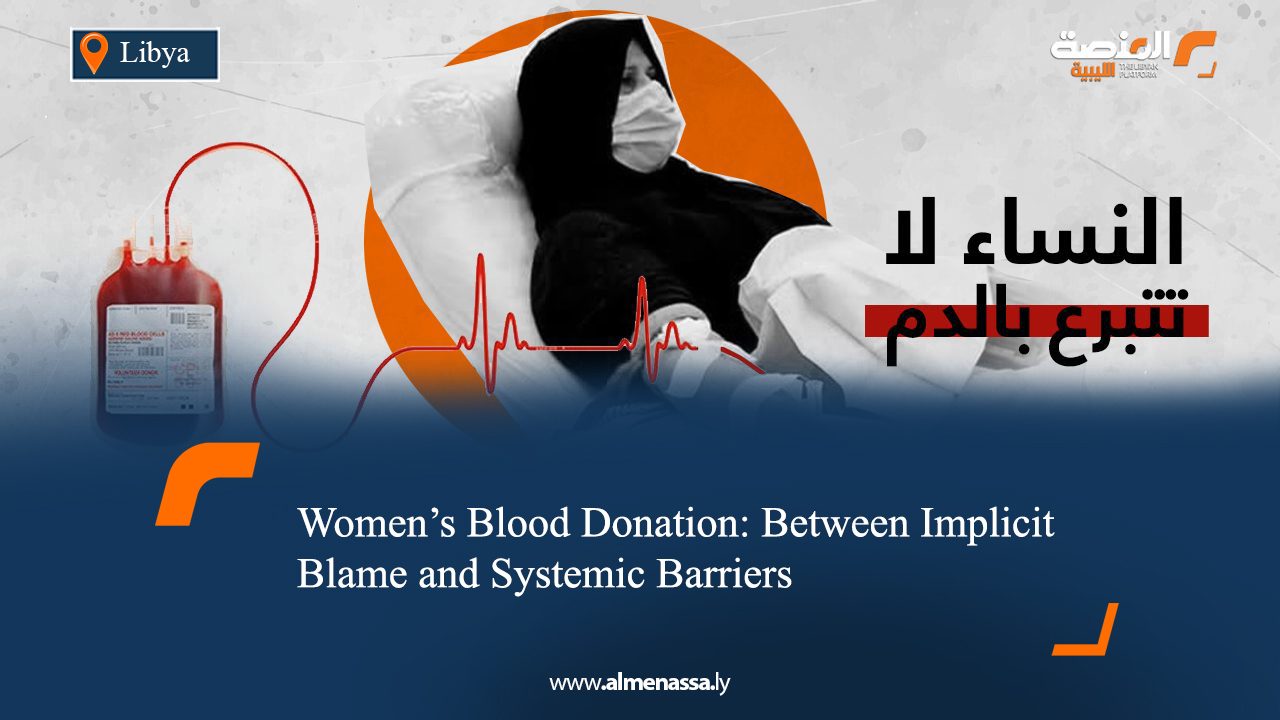In a move tinged with subtle reproach, Libya’s National Blood Transfusion Services launched a Facebook-based survey titled “A National Study to Understand Why Libyan Women Abstain from Donating Blood.”
The questions posed were direct: “Do you face difficulties? Do you have fears? Have you had a prior experience? Or have you simply never thought about it?”
When Iron Deficiency Tells Two Tales
The survey garnered widespread attention, prompting follow-up comments from the authority. It acknowledged that a segment of women do suffer from anaemia. It clarified that donation proceeds only after a brief check-up that confirms the ability to donate.
Notably, many women reportedly discovered they were anaemic only through the donation screening, which triggered timely medical intervention.
The Transfusion Authority added: “Although women comprise half of society, their contribution to blood donation remains insufficient in many countries, including Libya. This gap stems from inaccurate information and deeply ingrained misconceptions, depriving society of a vital humanitarian resource capable of saving thousands of lives.”
Among the most cited justifications were:
– “Women are always low on blood because of menstruation.”
– “Pregnancy causes chronic anaemia.”
– “Thyroid disorders are common among women.”
– “Blood banks reject female donations altogether.”
Menstruation: Myths vs Science
Responding scientifically and humanistically, the agency stated that menstrual blood loss of just 30–80 ml per cycle is negligible compared to the body’s total reserves.
Most healthy women have normal hemoglobin levels, and the body rapidly replenishes the lost blood. Blood donation is only approved if the donor’s hemoglobin meets the standard threshold: ≥12.5 g/dL.
According to the World Health Organization, women may donate blood even while menstruating as long as they’re in good health.
Pregnancy: A Pause, Not a Prohibition
Pregnancy doesn’t mean permanent disqualification. The agency recommends waiting 6 months post-delivery before donating.
After full recovery and the breastfeeding phase, women regain the strength needed to donate like any healthy adult. The policy standard excludes donations during pregnancy and for the first 6 months after childbirth, solely to safeguard maternal health.
Thyroid Conditions: Case-by-Case Eligibility
Some thyroid disorders, such as hypothyroidism, do not automatically disqualify a woman from donating blood provided her condition is stable and under medical treatment. However, individuals with active or uncontrolled thyroid dysfunction are temporarily ineligible until their health is regulated.
No Official Ban on Female Donors
The agency reiterated that there is no formal restriction preventing Libyan women from donating blood.
What’s needed, it argued, is a restoration of public trust and a dismantling of harmful myths by:
– Science-based, woman-friendly awareness campaigns
– Training blood bank staff to improve the donor experience
– Media engagement to promote the concept of the “female lifesaver”
– Scheduling flexibility and mobile donation units at universities and marketplaces
Women Speak: Rejection and Biology
Many women shared their personal experiences.
Lab technician Fatma Al-Ratil noted a widespread pattern of physicians refusing donations from female patients, which reinforced the public belief that women simply aren’t fit to give blood.
After being rejected at multiple facilities, Zainab Al-Munir’s last effort came at a Ghout Al-Shaal clinic, where she hoped to aid a patient needing O-negative blood. Staff refused, hinting that accepting her donation could invite legal trouble.
Despite insisting that she would take full responsibility, they stood their ground. Zainab left feeling as though donating blood had become a crime.
Abrika Al-Masmari added that many women are on medication that rules out donation, including hormonal thyroid replacements, insulin, or recovery drugs following Caesarean surgery, transfusions, or childbirth. Some were pregnant or nursing.
She pointed out that many women had hemoglobin levels hovering around 8–9 g/dL, which makes voluntary donation medically unsuitable in most cases.
Um Lujain noted that the blood bank staff declined her donation simply due to her thyroid condition, even though donors with no antibodies can be perfectly eligible.
Most women echoed a recurring theme: chronic anaemia was a significant barrier and was frequently misunderstood by donation facilities.
The Global Pattern: Germany and Jordan as Case Studies
A 2016 study by Germany’s Federal Centre for Health Education revealed:
– 56% of men had donated blood at least once
– Compared to just 42% of women
Men are allowed to donate six times annually, while women are permitted to donate four times over the same period.
According to spokesperson Marita Vollker-Albert, blood donation can cause iron depletion, which typically takes about 2 months to recover.
This recovery is slower among women due to menstrual loss. Additionally, women are more likely to be excluded based on health criteria, including iron deficiency, pregnancy, and breastfeeding.
In Jordan, a 2011 statement by acting Director of the Ministry of Health’s Blood Bank, Karim Yerfas, confirmed that “shame culture” continues to inhibit female donation.
A study of 821 voluntary blood donors showed:
– 91% of Jordanian women did not donate during standard blood drives
– That figure dropped to 76% within university-based campaigns
Gender disparities persisted at academic institutions:
At the German Jordanian University, 76% of donors were men vs 24% women.
At Al-Zaytoonah University, 81% were men and 19% women.
Yet Jordan remains globally advanced in donation rates, reaching 3.2% of the population, covering national needs and aligning with international targets of 3–5%.
The country’s blood bank reportedly collects 182,000 units annually.
A Change in Culture, Not Just Policy
Libya’s Central Blood Bank in Marj acknowledged that female donors remain significantly fewer than their male counterparts, largely due to societal misconceptions that blood donation harms women’s health.
Between the eager but rejected female volunteers and the entrenched cultural and clinical biases, Libya faces an urgent need for wide-reaching education not just for women, but for healthcare institutions and frontline donation centers alike.


